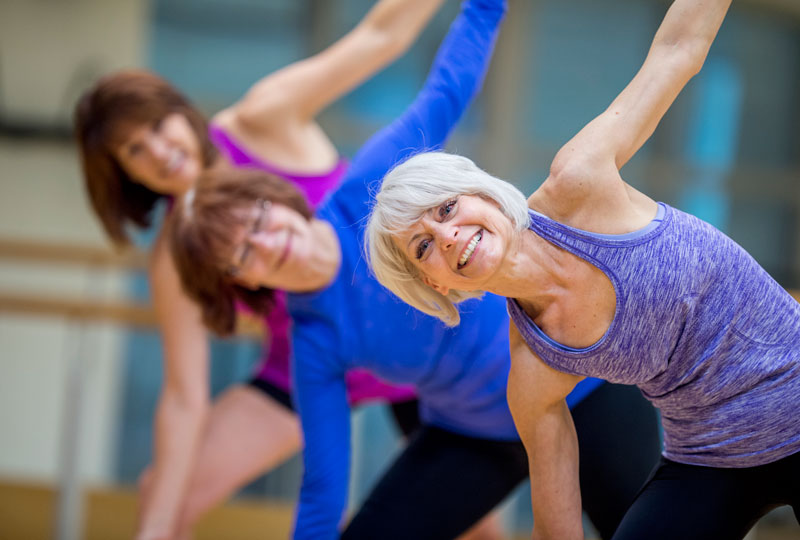A longtime health educator’s advice for fitness over 50 that energizes the middle years.
Physical activity has been part of my life since my teenage years, but as I’ve aged, my routine has changed.
My body can no longer handle the high impact workouts I used to do. I’ve switched my focus to a fitness routine that keeps me feeling youthful and healthy, and helps ensure that I will be able to keep up with future grandchildren the way I dream of.
Even if you had not been as active in the past, it’s never too late to pick up a physical activity routine. Check with your primary-care provider before beginning any new exercise program.
Focus on these four components of fitness over 50, and at any age, so you stay fabulous in your middle years:
Balance
Balance becomes increasingly important as we age because it can help reduce the chance of falling. Improving balance now can prevent a broken hip later from a stumble. Broken hips are a common injury among the elderly, and they often have serious effects on overall health.
For beginners, improve balance by simply shifting weight from one foot to the other while standing. Use a chair for support, if needed. For an intermediate challenge, practice standing on one foot or getting up from a chair without using your hands. For more advanced balance training, choose activities like tai chi, biking, walking lunges or yoga.
Range of motion
Range of motion refers to how fully your joints can flex and extend; can you move your spine and limbs in wide arcs, or is your motion limited to fewer degrees?
Flexibility in the joints tends to decrease as we age, which can increase the risk of injury and make us feel old and creaky. Daily gentle stretching of the upper and lower body and the spine can maintain or even improve range of motion. Be careful when stretching; improper techniques can cause more harm than good. Be sure the body is warm first — never stretch a cold muscle. Also, be sure that the stretch doesn’t cause pain. It should be a gentle tension only. Avoid bouncing or forcing the movement.
Tai chi, yoga and stretch-focused classes are great ways to increase range of motion. There are many beginner-friendly yoga classes available at community centers, YMCAs and private studios. There are even apps for yoga stretches you can follow on your phone or computer to do at home. Or incorporate these into your own fitness over 50 routines to do at home, under a shady park tree or at a fitness center.
Cardiovascular endurance
The American College of Sports Medicine recommends regular exercise that raises the heart rate to a moderate level for at least 30 minutes, most days of the week — no matter how old you are.
Get your heart rate up during consistent exercise to reduce the risk of numerous serious health issues, such as heart disease, diabetes, depression and hypertension. All these chronic illnesses become more common as we age. Our metabolisms slow down as we get older, particularly in post-menopausal women.
Being physically active can also help you maintain a healthy weight. For low-impact cardio options, try swimming, water aerobics, biking, walking, hiking or dancing to get your 30 minutes or more a day of cardiovascular exercise. Find options that you enjoy and you will be more likely to stick with them long-term. But add variety to avoid getting bored or burned out. And don’t rule out the idea of taking up running in middle age.
Many activities can be done independently, but if you prefer the idea of something more social, look for group programs such as Fifty Forward (in Middle Tennessee) or a gym or senior center. Many communities even have walking clubs where neighbors can stay fit together.
Muscle strength
The frailty and loss of strength we associate with older adults who cannot lift groceries, get out of a chair easily or climb stairs doesn’t have to happen to you. As a fitness over 50 goal, building muscle strength is a must.
Much of the weakness associated with these losses of independence is a result of reduced muscle mass. A combination of both the aging process and minimal physical activity can cause this. We obviously cannot control getting older, but by keeping our muscles strong we can hope to live a life that allows us to do the things we want to do for much longer.
Strength training — an exercise that strengthens muscles — also helps reduce the risk of osteoporosis (weakened bones), which develops with a loss of bone mass. According to the National Osteoporosis Foundation, men and women both experience bone loss as they age. Post-menopausal women can experience up to a 20 percent loss in bone density in the seven years after menopause due to significant reductions in estrogen. Weight-bearing exercise helps combat this. Lifting weights or strength training using one’s own body weight for resistance (for example, squats) helps prevent muscle mass from deteriorating and prevents some of the weakness that comes with aging. Free weights (barbells and dumbbells), weight machines and exercises such as planks and push-ups (that use body weight as resistance) are some examples of strength training to consider including in your routine two to three days a week.
Get your doctor’s clearance to begin a strength-training routine. If you’ve never done strength training, a personal trainer can help you find exercises and teach the correct form. You’ll gain strength and stamina while avoiding injury. Searching Google or YouTube will also yield many videos demonstrating strength training workouts appropriate for beginners. Be sure to follow those that take the time to explain proper form and offer variations on each move so you’re not attempting exercises that are too advanced or might lead to injury.
Fifty is the new 30! People are living longer and more vibrant lives than ever before. Lead an active fitness over 50 life that allows you to fulfill your physical dreams and incorporate these into your daily routine.
Stacey Kendrick, MS, is a health educator with more than 20 years of experience in wellness and population health. She is a mother to two adult daughters. In her free time, she teaches healthy cooking classes, runs, gardens and enjoys backyard bonfires.

Are you or your loved ones on Medicare? If so, make sure to take advantage of your free Medicare annual wellness visit by the end of the year. Ask your doctor about an annual wellness visit so you can be sure you are doing everything you can to stay as healthy as possible.

